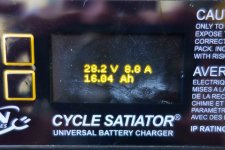tln said:
Random thought: maybe the pack/charge cable could help determine the correct profile? I'm imagining DIP switches on a tiny board that identify a profile and use the LIN bus connector thingy.
It's not a bad random thought. We've deliberately left automatic profile selection process uncommitted at this stage. One of the easiest ones to implement would just be a fixed resistance between the signal pin and ground. Currently, the signal pin can do digital communication via LIN or it can measure the thermistor resistance between the Pin and Gnd for temperature sensing in NiMH/NiCad modes. But in lithium and lead modes and -dV Nickel modes it isn't used, so we have an option where the profiles are chosen automatically based on the resistance, so you could have it like
0.8-1.5 kOhm = Profile 1
1.5 - 3K = Profile 2
3K - 5K = Profile 3
...
...
>20K = user select
This would mean you'd just need to put a resistor on the XLR charge port of any battery pack you have and map it to the correct profile on the satiator, without any additional smart logic or communication, and have all your batteries load their profile automatically. It'd work fine for individual or private fleet applications, but not really a widerspread universal solution. For that I think we're going to wait and see what happens with the energybus standard and most likely adopt that route, with a charge calbe that has a LIN->CAN converter built in.
http://www.energybus.org/
On a different note, the 0.815 firmware available for download, just small internal tweaks over the 0.814
http://www.ebikes.ca/product-info/grin-products/cycle-satiator.html
And, we're also getting very close to having the computer software for setting up and custom naming and ordering your profile list.

Our target is to have this ready for beta users in time for demonstrating at Interbike, so give it a week or so.



